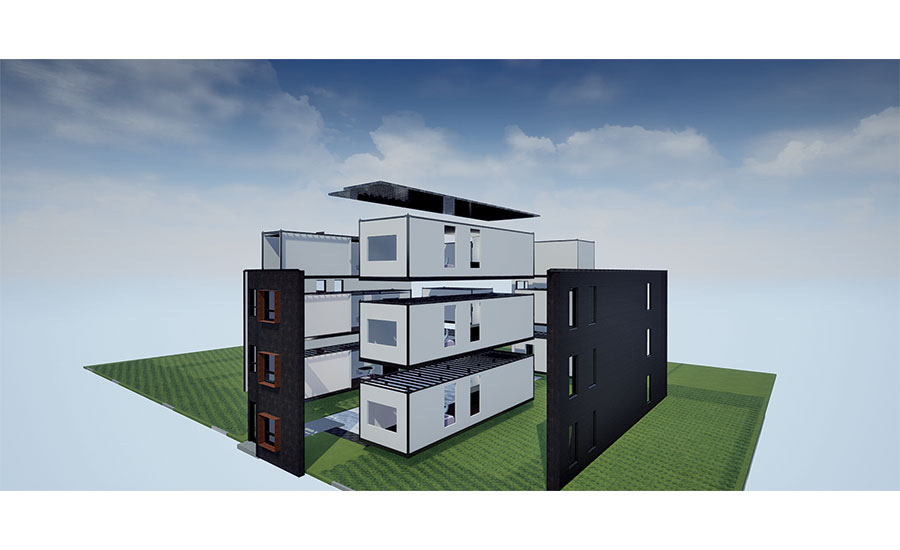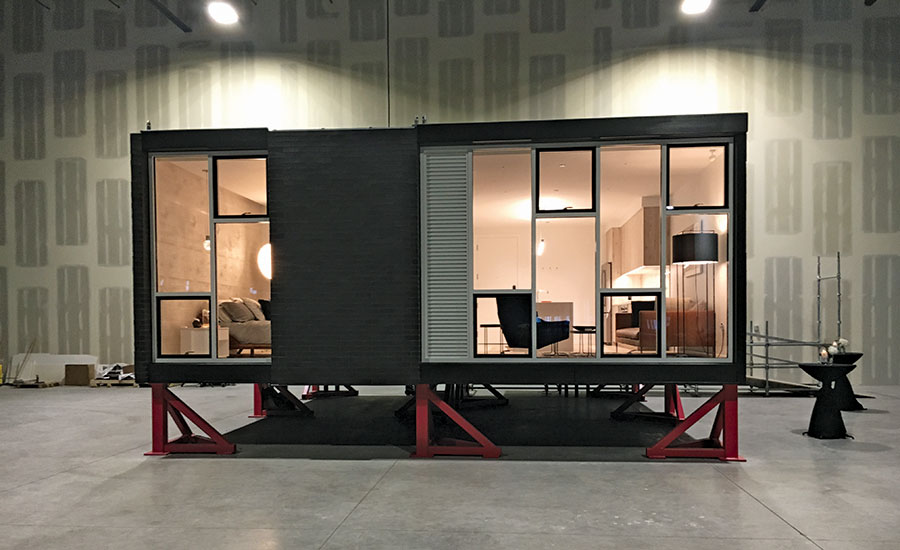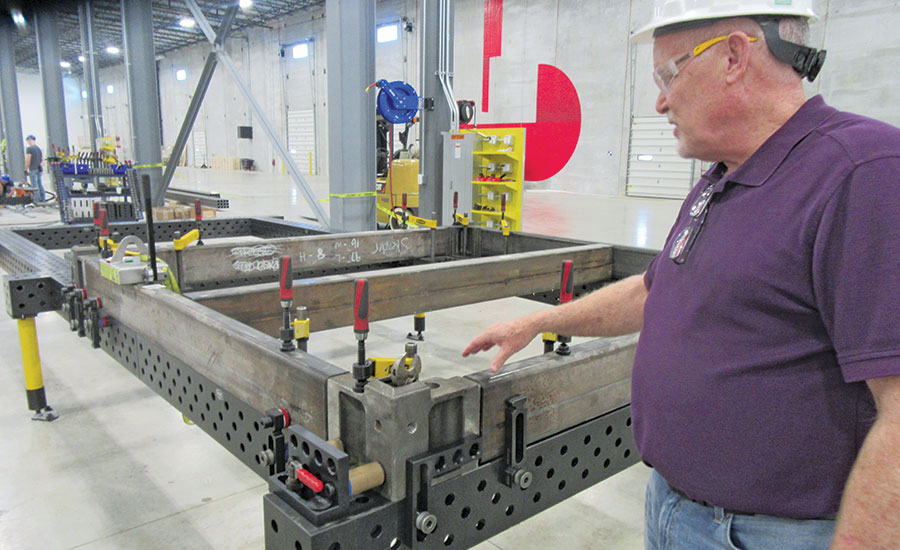Skender Pursues a Mission to Boost Its Modular Capabilities

Skender’s three-flat buildings for Sterling Bay will each have a modular unit produced in its manufacturing facility and installed into the frame on site.
IMAGE COURTESY OF SKENDER

This one-bedroom apartment unit was built at Skender’s facility as a proof of concept.
IMAGE BY JEFF YODERS/ENR

Manufacturing President Peter Murray oversees design of the production line.
IMAGE BY JEFF YODERS/ENR

The three-flat is a common building type originally designed for worker housing in Chicago’s neighborhoods. This rendering shows Skender’s three-flat concept placed on a typical neighborhood street.
IMAGE COURTESY OF SKENDER




On a hot day in early June, Peter Murray and Stacy Scopano discussed how to set up a modular apartment production line at Skender’s 105,560-sq-ft manufacturing facility on Chicago’s southwest side.
“We’re playing with it at this point,” Murray, Skender’s president of manufacturing, said back then. Murray has nearly 30 years of experience in both modular building and medical-device manufacturing.
“It’s fast. [Conduit and piping] come pre-bent, and we’re building this line over and over again and refining our process. As we fine-tune our process, our suppliers can fine-tune their processes. It’s not a job shop where they build 30 of them and we never see the supplier again. They’re tooling up as we are,” he said.
The plan was for a former warehouse space to produce affordable-rate, three-floor, three-unit apartment buildings whose units can be plugged into a steel structure built on site by Skender in several Chicago locations for developer Sterling Bay. The three-flat, a common Chicago building type, would help Sterling Bay provide affordable housing for high-rise projects under construction that don’t have those units, as part of the developer’s commitment to the Chicago Housing Authority. Skender’s chief technology officer, Scopano, said they can complete this type of project in only nine weeks, or 80% faster than a three-flat built using traditional methods.
Scopano previously held executive positions with Skanska, Autodesk and Trimble. Both Scopano and Murray have been with the contractor for less than two years, hired to help lead the new manufacturing project.
“The idea is to have each line cranking out two mods (modules) a day, scalable to three full production lines, so that’s up to six mods a day if we decide to do only one shift,” Scopano said. “We have the ability to do more. The reverse benefit of digitizing each part of the construction and installation process is flexibility. Can we go to design and say, ‘Can we move this part or do we have to take more customization to it? Can we reconfigure the supply differently or throw a different set of automation features at it?’ ”
Murray said the company has an “incredibly strong core of both manufacturing and construction.” He cited the expertise of leaders like Scopano and chief design officer Tim Swanson, who joined Skender from CannonDesign, where he was Chicago office practice leader.
That leadership paid off when the first two modular housing units rolled off Skender’s production line the week of Aug. 14—less than 60 days after start up.
Pursuing a New Model
What Skender has become, with its new manufacturing model in place, might look like science fiction compared to what Joseph Skender Sr. envisioned when he started his eponymous construction company in 1955. It focused then on carpentry and remodeling projects and had less than 10 employees. Last year, Skender booked $430 million in worldwide revenue and had 270 employees. It was named sixth on Crain’s Chicago Business list of best places to work last year.
“We came up with a more vertically integrated model,” says Mark Skender, Joseph Sr.’s son, and the company’s CEO since 2014. “If we design, engineer, manufacture and construct, we really can control the data and the designs—and the engineering of the buildings or building components. So that kind of gave us a great platform to do something that was bold,” he says.
“There’s also the philosophy of innovation and lean. We’ve been heavily invested and committed to lean construction principles over the last 12 to 14 years. That kind of gave us permission to start exploring this three years ago,” he says.
“If there were no constraints on the industry, what could we do?”
– Mark Skender, CEO, Skender
Mark, who holds an MBA from Northwestern’s Kellogg school of management, sounds like a business-school grad when he talks about vertical integration or lean construction. But his rise in the family company was more about hard work and building the business from within than being a futurist or a visionary.
“In the early years, we were a small contractor that developed either single-family or small commercial-room additions,” Mark says. “My brother Joe [Jr.], who just retired, is seven years older than I am. So he’d had a lot more experience with my father, but both of us worked in the field. It was a lot of hard work, and we learned from the experience how to do things right and deal firsthand with customers.”
Joseph Jr. joined the company after graduating from DePaul University in 1980, and Mark joined in 1990, shortly after earning his degree in civil and environmental engineering from the University of Wisconsin. Toward the end of the ’80s, the Skenders undertook two major projects, a mixed-use residential building in Mount Prospect, Ill., and the company’s first senior-housing project, for the Franciscan Sisters of Chicago.
Throughout the ’90s, Joseph Jr. and Mark developed growth strategies as the firm won increasingly significant bids and solidified its corporate culture. In the early 2000s, Skender broke $30 million in revenue and established itself as a contractor of choice in Chicago’s senior-housing market. Joseph Jr. retired as chairman in January of this year, but he and Mark began working on the company’s manufacturing goals long before that.
Shortly after Mark became CEO in 2014, the company reorganized and awarded partnership stakes to several longtime employees. They “helped us get here. It’s a little bit different changing from a family business, but we’re trying to keep those values,” he says.
In November 2017, Mark began talking to the rest of the company’s leaders about a study released that year by McKinsey & Co. on how to reinvent construction.
“We took that very seriously because it laid it out very well,” he says. “So I challenged the leadership team to think, read the study and come in with some ideas that if there were no constraints on the industry, what could we do?”
Skender’s more vertically integrated model grew directly out of those meetings, and the last three years have been all about the company implementing its design-build-manufacture-construct plans.
Labor Questions
One hurdle to creating the new manufacturing facility was labor. Skender is a 50-plus-year partner with the Chicago Regional Council of Carpenters (CRCC). Skender employs local union workers, and the company did not want to open its manufacturing facility without creating a path to send future workers to unions.
“There were a lot of helping hands, a lot of people that made a difference,” says Gary Perinar, executive secretary-treasurer of the 30,000-member CRCC. “We were able to secure a shop agreement for these new individuals that are working in the facility. It’s obviously a lesser rate than a journeyman carpenter would demand working in a high-rise or buildings downtown, but they’re starting, they’re getting trained up.” Perinar says there is a path for the workers at Skender’s modular factory to become journeyman carpenters if they choose to pursue it.
The new modular units use supplier-provided electrical and mechanical components—pre-bent conduit, piping and HVAC. Still, the Mechanical Contractors Association of Chicago says it’s willing to work with Skender on similar projects. “It is exciting to see Skender showcasing a modularization method,” says Dan Bulley, senior vice president of MCA Chicago. “We support innovative ideas like this and other mechanical-specific innovations like flying factories and jobsite module manufacturing.”
Other critical milestones included approval from Chicago’s Dept. of Buildings. The election of Chicago Mayor Lori Lightfoot, who was present for the June ribbon cutting at Skender’s facility, helped the firm smooth a few more edges toward the opening.
“The affordable [housing] requirements ordinance has only produced, really, a small amount of actual affordable housing,” Mark says. “There is this willingness with a new mayor to address neighborhood development, and I think this time the city is willing to look at a policy to create more housing affordability.”
Murray says Skender plans to hire 100 people to work in its facility this year and already has 35 working on the first production line. Depending on demand, Skender plans to produce health care and multifamily high-rise mods, and that could increase the facility’s workforce to 150 by the end of next year, he says.









